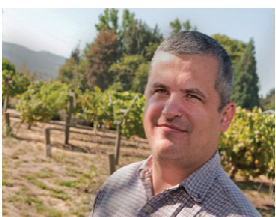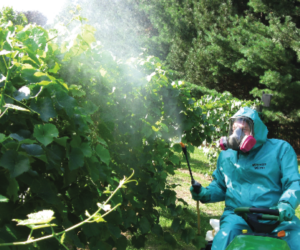One of the biggest challenges to growing grapes — commercially or recreationally — is controlling vine growth, which is known as vigor. If the vines are too productive, or not productive enough, the grapes (and resulting wines) will suffer. Two grape growing experts share some vigor advice for finding a happy medium in your backyard.
 Gabriel Balint, Ph.D Research & Extension Viticulture/Enology Program, Oregon Wine Research Institute, So. Oregon Research & Extension Center, Central Point, Oregon. After receiving bachelor and masters degrees in horticulture and crop protection in Europe, Gabriel pursued a Ph.D degree in viticulture and oenology from Brock University in St. Catharines, Ontario.
Gabriel Balint, Ph.D Research & Extension Viticulture/Enology Program, Oregon Wine Research Institute, So. Oregon Research & Extension Center, Central Point, Oregon. After receiving bachelor and masters degrees in horticulture and crop protection in Europe, Gabriel pursued a Ph.D degree in viticulture and oenology from Brock University in St. Catharines, Ontario.
To determine vigor in your own potential vineyard, first think about what you want to plant. Many people make mistakes in choosing the right variety for a specific location. They plant what they like to drink and not what variety would perform the best at that location. Other questions you need to ask yourself are: How fertile is the soil? Is there a permanent source of water? Where is the property is located (slope, orientation, floor, elevation)? I would also want to know the site’s growing degree days (heat units), first and last frost dates for that location. I always suggest to people who want to grow grapes to look to their grape-growing neighbors and talk to them before planting. They might avoid some costly mistakes.
Look for properties on slopes, ideally 2–5% grade. In the spring, look for water puddles; they might indicate drainage issues. Gravel and stones might indicate good drainage. Look at the vegetation in summer. Is it green? Do the plants have a lot of growth?
Before you plant anything, start with a soil test. The chemistry should tell you how fertile the soil is. Try to avoid too much organic matter or nitrogen. Also look for the physical properties of the soil. It’s important to know the soil texture (how much clay, sand and loam). Ideally, dig a couple of pits and take a look at the soil profile before planting. You can find how deep the soil is, what the soil profile looks like and how deep the water table is. A self-rooted vine can grow more than 6 feet (1.8-m) in the first year if the soil is really fertile. For grafted vines you might assess the vigor in the second or third year.
If you have vines that aren’t exhibiting adequate vigor, first try to determine the cause with some leaf or petiole samples. If the nutrition reports are looking good, take some root samples and check for nematodes and Phylloxera. Also look for any virus infection. Some viruses don’t show symptoms but can devigorate the plants. Another cause might be poor water management. However, if only a few vines show lack of vigor I would simply prune more severely (leave less buds on the vine than normal).
If there is too much vigor, avoid adding any fertilizers or water. You can also change the trellis and training system to accommodate the vigor. You can divide the canopy (horizontally or vertically) in order to keep the right vine balance. Scott Henry, Lire or Geneva Double Curtain are a few of the trellis systems that work well in vineyards with high vigor. Another practice to devigorate the vine is leaving many more buds than normal at pruning. Picking the right scion/rootsock combination is another way to deal with high vigor. Some rootstocks can devigorate the vine but still keep the balance between fruit and vegetation. There are also some studies that showed that cover crop can devigorate vines because they are coming in competition for the same water and nutrient resources.
I recommend to people who want a vineyard to do their homework before they plant any vines. It’s much easier to prevent problems than to correct them after the vines are in the ground. Ask your regional extension grape advisor or your neighbors to share their experiences. Sometimes you learn better from your own mistakes, but it also takes longer to achieve your objective.
 Jodi Creasap Gee, Program Director of Viticulture and Enology at Kent State University – Ashtabula, in Ohio. Jodi completed her Ph.D in plant pathology at Cornell University and her Ph.D on grape crown gall from Cornell University’s Department of Plant Pathology. After completing a post doctorate at Michigan State University, Jodi worked for the Lake Erie Regional Grape Program, with Cornell Cooperative Extension.
Jodi Creasap Gee, Program Director of Viticulture and Enology at Kent State University – Ashtabula, in Ohio. Jodi completed her Ph.D in plant pathology at Cornell University and her Ph.D on grape crown gall from Cornell University’s Department of Plant Pathology. After completing a post doctorate at Michigan State University, Jodi worked for the Lake Erie Regional Grape Program, with Cornell Cooperative Extension.
Soil assessment, first and foremost is the first step in determining the vigor of a potential vineyard site. I would first ask a potential grower whether they had completed a soil test on the location primarily to assess the soil organic matter, which will have a huge impact on vine vigor. The optimal range is between 3–5% soil organic matter; soils with higher than 5% can lead to excessively vigorous vines that are difficult to tame, which can lead to challenges in fruit quality. A soil test is the first step in evaluating the site for vineyard development. Soil type will play a major role in water drainage, which is vital to grape production. Heavy, poorly drained soils will not grow healthy vines, and sandy soils often do not have the organic matter to provide enough nutrients to vines.
Regional and local winter temperatures are also important. In my region – the Northeastern United States – winter lows are critical in grapevine growth and development. Target temperatures range from -10 to -5 °F (-23 to -21 °C) for most varieties, although a handful of newer hybrids can tolerate temperatures down to -35 °F (-37 °C). When considering planting a vineyard, the first key strategy is to determine the general vigor of that variety and whether a low- or high-vigor rootstock is necessary.
The sooner a would-be grower plans a vineyard planting, the better. From soil testing to site evaluation – checking winter lows for one to two seasons – from the planning phase to the planting phase, plan on two years, especially if a site requires any adjustments, whether with fertilizer or with landscaping. If a grower is in a time crunch, however, it may be possible to evaluate and prepare a site in one year. Check with websites like http://lergp.org for resources and information on pre-planting stages.
 Gabriel Balint, Ph.D Research & Extension Viticulture/Enology Program, Oregon Wine Research Institute, So. Oregon Research & Extension Center, Central Point, Oregon. After receiving bachelor and masters degrees in horticulture and crop protection in Europe, Gabriel pursued a Ph.D degree in viticulture and oenology from Brock University in St. Catharines, Ontario.
Gabriel Balint, Ph.D Research & Extension Viticulture/Enology Program, Oregon Wine Research Institute, So. Oregon Research & Extension Center, Central Point, Oregon. After receiving bachelor and masters degrees in horticulture and crop protection in Europe, Gabriel pursued a Ph.D degree in viticulture and oenology from Brock University in St. Catharines, Ontario.
 Jodi Creasap Gee, Program Director of Viticulture and Enology at Kent State University – Ashtabula, in Ohio. Jodi completed her Ph.D in plant pathology at Cornell University and her Ph.D on grape crown gall from Cornell University’s Department of Plant Pathology. After completing a post doctorate at Michigan State University, Jodi worked for the Lake Erie Regional Grape Program, with Cornell Cooperative Extension.
Jodi Creasap Gee, Program Director of Viticulture and Enology at Kent State University – Ashtabula, in Ohio. Jodi completed her Ph.D in plant pathology at Cornell University and her Ph.D on grape crown gall from Cornell University’s Department of Plant Pathology. After completing a post doctorate at Michigan State University, Jodi worked for the Lake Erie Regional Grape Program, with Cornell Cooperative Extension.





